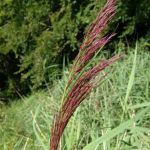
|
| Common Reed |
It contains asparagine, a diuretic, as found in Asparagus officinalis (See, Asparagus). Phragmites is from the Greek phragma, "fence" or "screen", and abbreviation of the description kalamos phragmata, "reed of hedges".
Vigorous, rhizomatous reed with robust stems and arching, pointed, linear leaves, to 60cm (24in) long, turning golden brown in autumn. Purple-brown spikelets are produced in erect to penden panicles, to 45cm (18in) long, in late summer and autumn, persisting into winter. Found in temperate and tropical regions worldwide.
Has yellow-striped leaves and is less invasive. |
|